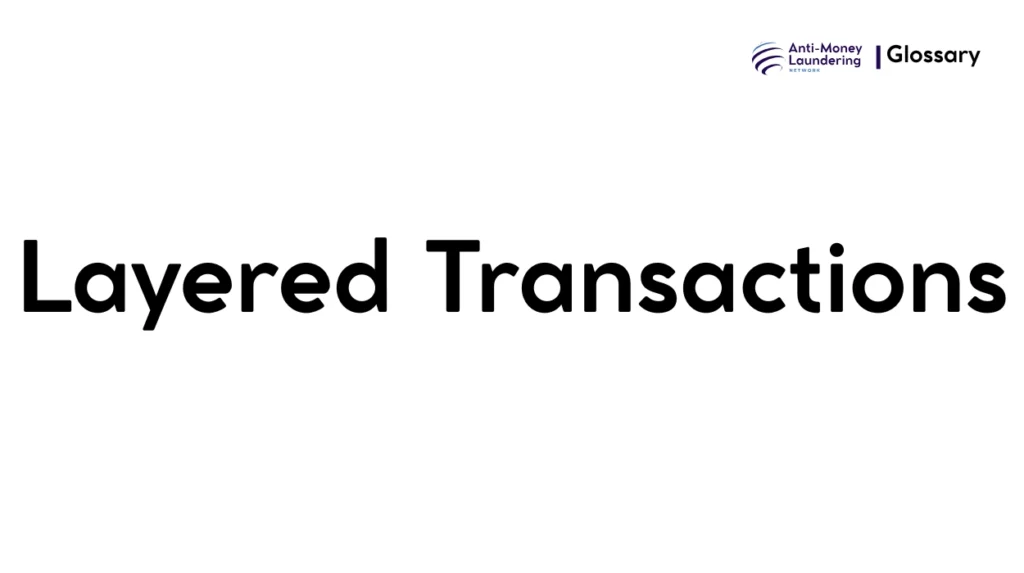Definition
Layered transactions in Anti-Money Laundering (AML) refer to the second stage of the money laundering process known as “layering.” It involves conducting a series of complex, multi-step financial transactions designed to obscure the origin of illicit funds and sever links to their criminal source. The core objective of layering is to create multiple layers of transactions across various accounts, jurisdictions, and asset types, making it challenging for law enforcement and compliance officers to trace and link the money to illegal activities.
Purpose and Regulatory Basis
Role in AML
Layered transactions serve a crucial role in the overall AML framework by dismantling the audit trail of illicit funds. Their complexity hampers efforts to detect and disrupt money laundering, thereby allowing criminals to integrate dirty money into the legitimate financial system undetected. Effective AML measures target this phase to prevent the legitimization of criminal proceeds.
Why It Matters
Detecting layering is vital because it is the stage where criminals employ sophisticated methods to hide their tracks. Failure to identify and report layers can facilitate drug trafficking, fraud, terrorism financing, corruption, and other financial crimes.
Key Global and National Regulations
- FATF Recommendations: The Financial Action Task Force mandates member countries to implement robust controls over layering through Customer Due Diligence (CDD), Suspicious Activity Reporting (SAR), and Enhanced Due Diligence (EDD).
- USA PATRIOT Act: Requires U.S. financial institutions to monitor and report suspicious or complex transactions consistent with layering.
- EU Anti-Money Laundering Directive (AMLD): Imposes rigorous Know Your Customer (KYC) procedures and transaction monitoring to prevent layering.
When and How It Applies
Layering usually occurs after the initial placement of illicit funds into the financial system. Criminals move money across multiple accounts and jurisdictions, converting it into different currencies or asset types to obscure its source. Examples include:
- Transferring funds between offshore accounts.
- Purchasing high-value goods (art, real estate) and then reselling.
- Using shell companies or trusts for complex ownership structures.
- Converting currency multiple times or investing in cryptocurrencies.
Triggers for layered transactions can include unusually large or frequent transactions, transfers with no clear business rationale, and patterns that deviate from a customer’s typical profile.
Types or Variants of Layering
Layering can take various forms, including:
- Geographical Layering: Moving funds across different countries to exploit jurisdictional discrepancies.
- Asset-based Layering: Converting funds into tangible or intangible assets.
- Transaction Splitting: Breaking large transactions into smaller ones to avoid detection (structuring).
- Complex Ownership Structures: Using multiple entities (shell companies, trusts) to conceal beneficial ownership.
Each form adds complexity and challenges to AML detection.
Procedures and Implementation
Financial institutions must implement comprehensive systems and controls to detect and prevent layering:
- Risk-Based Customer Due Diligence: Assess and monitor customers based on risk profiles.
- Transaction Monitoring Systems: Use automated tools to identify suspicious patterns indicative of layering.
- Enhanced Due Diligence: For high-risk customers or transactions, conduct deeper investigations.
- Staff Training: Educate employees to recognize layering red flags.
- Record-Keeping: Maintain thorough documentation to reconstruct transaction flows.
These procedures are typically integrated into broader AML compliance frameworks.
Impact on Customers/Clients
From the customer perspective, layered transaction controls may result in:
- Enhanced Verification: More frequent KYC update requirements.
- Transaction Delays: Additional checks on complex or high-value transfers.
- Restrictions: Possible freezing or blocking of suspicious transactions.
- Privacy Considerations: Institutions balance compliance with customer rights.
While sometimes inconvenient, these safeguards help protect clients from financial crime consequences.
Duration, Review, and Resolution
Layering detection is an ongoing obligation. Key practices include:
- Continuous Monitoring: Transactional data is reviewed in real time or periodically.
- Periodic Risk Reviews: Customer profiles and activity patterns are reassessed.
- Investigation and Resolution: Suspicious findings prompt internal inquiries, with resolutions documented.
- Retention: Record retention aligns with regulatory mandates, often several years.
Exiting layering involves either dismissal of suspicion or escalation through Suspicious Activity Reports.
Reporting and Compliance Duties
Institutions are responsible for:
- Detecting and investigating suspicious layering activities.
- Filing SARs with designated authorities when suspicion arises.
- Maintaining audit trails and evidential documents.
- Cooperating with regulators and law enforcement during investigations.
- Ensuring penalties are understood internally to foster compliance culture.
Non-compliance can lead to fines, sanctions, and reputational damage.
Related AML Terms
Layered transactions are closely connected to:
- Placement: The initial introduction of illicit funds.
- Integration: The phase where laundered money re-enters the economy.
- Structuring: A technique often overlapping with layering, involving fragmented transactions.
- Enhanced Due Diligence: A heightened scrutiny process triggered by layering risk.
- Suspicious Activity Reporting: Formal mechanism to alert regulators of potential layering.
Understanding these terms provides a holistic AML framework view.
Challenges and Best Practices
Common Challenges
- Identifying layering amid high transaction volumes.
- Complex cross-border regulations and jurisdictional gaps.
- Rapid evolution of laundering techniques using new technologies.
- Balancing privacy with stringent monitoring.
Best Practices
- Deploy advanced technology like AI and machine learning for pattern recognition.
- Foster a risk-aware culture with specialized AML training.
- Collaborate internationally to bridge jurisdictional gaps.
- Keep AML programs adaptive to emerging typologies.
Recent Developments
- Increased use of machine learning and anomaly detection to spot layering quicker.
- Regulatory emphasis on cryptocurrency and digital asset transactions.
- Enhanced international cooperation frameworks (e.g., FATF updates).
- Growing scrutiny on non-financial entities susceptible to layering risks.
Layered transactions are a fundamental and complex phase in the money laundering process, where illicit funds are obscured through sophisticated financial maneuvers. For compliance officers and financial institutions, understanding layering is essential to detect, disrupt, and report suspicious activities effectively. Robust AML systems, combined with regulatory adherence and technological advancements, are critical to combating this challenge and maintaining the integrity of the financial system.

